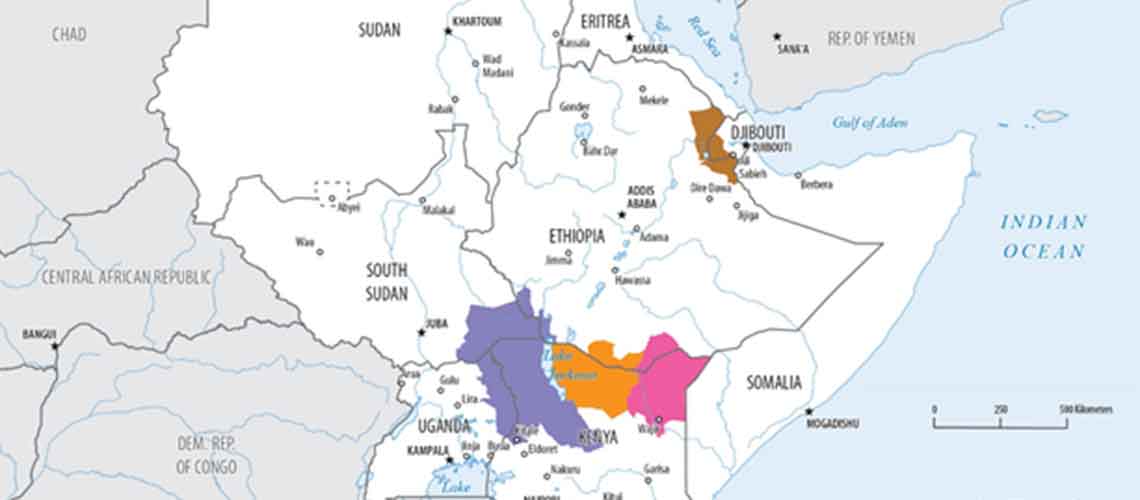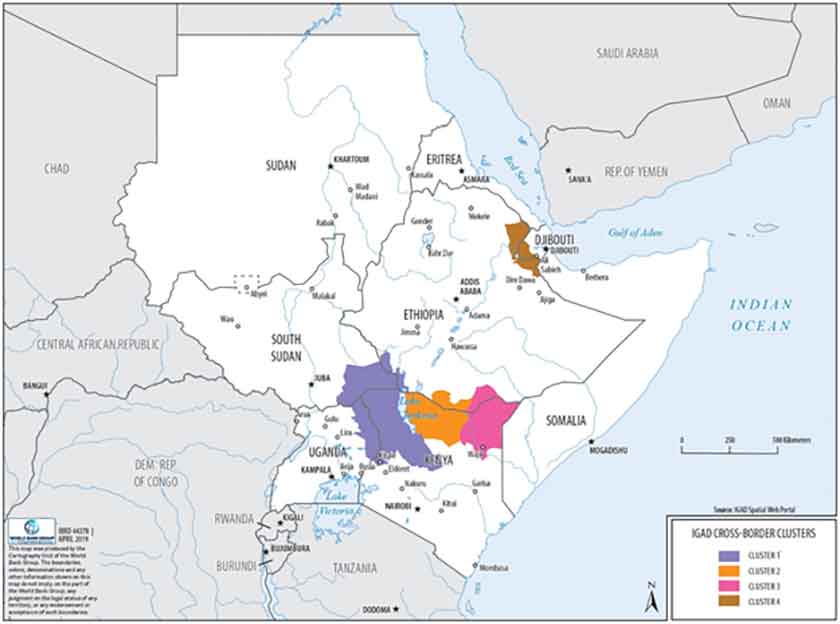 Cross-border “clusters” identified by the Intergovernmental Authority on Development (IGAD)
Cross-border “clusters” identified by the Intergovernmental Authority on Development (IGAD)
The borderlands in the Horn of Africa are synonymous with economic, social, and political marginalization, entrenched poverty, persistent con¬flict, forced displacement, and envi¬ronmental degradation. However, these borderlands also support livelihood systems and opportunities for more than100 million people in pastoralism and trade. They are closely connected to circuits of regional and global trade and host well-knit social networks based on cross-country clan and ethnic affiliations.

Cross-border “clusters” identified by the Intergovernmental Authority on Development (IGAD). These have been identified based on their demonstrated importance in terms of human and animal cross-border movement, and the need for regional cooperation.
Recognizing that the challenges and vulnerabilities and responses are not confined within national boundaries, a new World Bank report, “From Isolation to Integration: The Borderlands of the Horn of Africa” explicitly challenges policymakers to adopt a ‘borderlands perspective.’ The report emphasizes the need to consider the specific historical, political, social and economic contexts of these border regions when formulating policies and investments. For example, infrastructure projects such as roads, railways, communications, and irrigation, are not only public goods that allow “lagging areas” to catch up to the rest of the country, but also have significant impacts on the cross-national livelihoods and trading relationships of communities residing in borderlands.
Among the most significant of the challengesin the Horn is widespread insecurity and violence as a result of inter-state conflict, criminal activity, localized contestations over resources, and violent extremism. Unsurprisingly, the effects of conflict are heavily gendered. Young men are more likely to be affected by traditional practices around cattle raiding as they take part in raids and protect the cattle. Women on the other hand may be disproportionately affected by challenges faced when collecting firewood, water, and food; gender-based violence due to heightened insecurity, as well as forms of structural patriarchy including limited access to productive assets. Men and women are also differently challenged in the borderlands by the high levels of forced displacement, food insecurity, environmental degradation and climate change vulnerability, natural hazard risks.
Nonetheless, sources of resilience exist, many of which are oriented around the crossing of national borders. The borderlands are characterized by robust trade, and especially livestock exports, which tap markets in Egypt and the Middle East even in times of conflict, and in the face of climate crises and external market shocks. Cross-border informal trade also plays a critical role across the region and is dominated by women. Traditional and informal community institutions (often based on clan or ethnicity), though weakened, still play a significant role in regulating the livestock trade, managing trade relations, and resolving disputes in areas where the state has limited reach.
Regional challenges require regional action in the borderlands and three key conclusions are:
- First, regional collaboration at the policy and institutional levels is required to ease the flow of capital, labor, goods, and services across borders.
- Second, to mitigate the impact of geographic isolation and neglect, investments are needed in basic infrastructure and social services, such as roads, energy, education, health, water, information and communications technology, and access to finance.
- Finally, the capacity of formal and informal institutions for conflict management and violence prevention need to be strengthened - particularly when dealing with the gendered impact of conflict, insecurity, and violence.
A borderlands perspective does not yield simple policy prescriptions. However, by emphasizing the need to pay attention to the context, history and spatial dynamics of border regions, it offers an analytical lens which can help development actors craft better policies and investments.



Join the Conversation